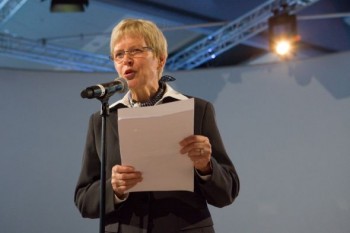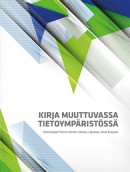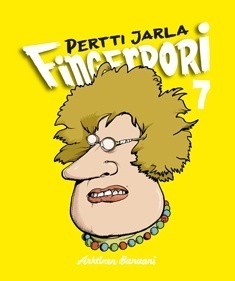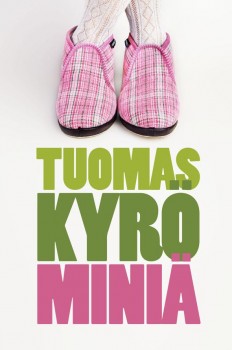Tag: book trade
Not a world language, and yet….
16 January 2015 | Articles, Non-fiction

The editors (Hildi Hawkins and Soila Lehtonen) at the screen: we begun publishing material on our website in 1998. Photo: Jorma Hinkka, 2001
Longevity may not generally be a virtue of literary magazines – they tend to come and go – but Books from Finland, which began publication in 1967, has stuck around for a rather impressively long time. Literary life, as well as the means of production, has changed dramatically in the almost half-century we have been in existence. So where do we stand now? And what does the future look like?
This is the farewell letter from the current Editor-in-Chief, Soila Lehtonen – who began working for the journal in 1983
‘The literature of Finland suffers the handicap of being written in a so-called “minor” language, not a “world” language…. Finland has not entirely been omitted from the world-map of culture, but a more complete and detailed picture of our literature should be made available to those interested in it.’
Thus spake the Finnish Minister of Education, R.H. Oittinen, in early 1967, in the very first little issue of Books from Finland, then published by the Publishers’ Association of Finland, financed by the Education Ministry.
Forty-seven years, almost 10,000 printed pages (1967–2008) and (from 2009) 1,400 website posts later, we might claim that the modest publication entitled Books from Finland, has accomplished the task of creating ‘a more complete and detailed picture’ of Finnish literature for anyone interested in it. More…
And cool it was
30 October 2014 | This 'n' that

Guests welcome: Finnish pavilion, Frankfurt Book Fair. Photo: Katja Maria Nyman
Finland was Finnland and cool as Guest of Honour at the Frankfurt Book Fair from 8 to 12 October.
There was plenty to choose from, and then some: more than 500 Finland-related events, readings, exhibitions and cultural projects, 50+ Finnish authors, books, pictures, videos, music.
More than 130 books (plus new editions) have been published in German this year, and interest in Finnish literature in other countries – Frankfurt is the world’s biggest book fair, and publishers from all over the world are represented – will inevitably grow.
So the Finnish organiser, FILI – Finnish Literature Exchange – and its staff has now put their feet up for a moment, as it were, after very successfully tangoing through it all, and are savouring all the wow-factor memories of this big enterprise. After several years of preparation and hectic last months, it seems international interest in literary things Finnish exceeded all expectations.

Ready to begin: Finnish Pavilion, Frankfurt Book Fair. Photo: Katja Maria Nyman
For those of you who couldn’t make it to the Finnish Pavilion, there are photographs of various events at Frankfurt, and lots more on this site, so take a look. Vorwärts! / Onwards!
Translation prize to Angela Plöger
23 October 2014 | In the news

Angela Plöger, Frankfurt Book Fair, 8 October. Photo: Katja Maria Nyman
The 40th Finnish State Prize for the Translation of Finnish Literature of 2014 – worth €15,000 – was awarded to the German translator Angela Plöger at the Frankfurt Book Fair on 8 October.
Dr Angela Plöger (born 1942) studied Finnish and Fennistics in Berlin; she first came to Finland in the 1960s after having become interested in the Finnish language as a result of learning Hungarian.
‘I had been to the restaurant at the Helsinki Railway Station where Bertolt Brecht was thinking how the noblest part of a man is his passport, and how Finns are a people who keeps silent in two languages.’
Plöger then defected to West Germany, starting her career anew. She has also translated texts from Hungarian and Russian. In her speech in the Finnish Pavilion of the Book Fair Plöger said that in her opinion translating literature is the most fascinating profession in the world.
Her first translation of a Finnish novel was Tamara, by Eeva Kilpi, published in 1974. Among the most recent of the 40 novels Plöger has translated during the past five decades from Finnish are the novels Kätilö (‘Midwife’, 2011) by Katja Kettu and Kun kyyhkyset katosivat (‘When the doves disappeared’, 2012) by Sofi Oksanen. Among the other works Plöger has translated are novels by Leena Lander, Eeva-Kaarina Aronen, Anja Snellman, Kaari Utrio, Johanna Sinisalo, Risto Isomäki and Antti Tuuri, as well as a number of drama texts by Laura Ruohonen, Juha Jokela, Aki Kaurismäki, Pirkko Saisio and Sofi Oksanen.
The Minister for Culture and Housing, Pia Viitanen, thanked Plöger for her extensive and multi-faceted work in the field of language and literature and in promoting Finnish literary culture in Germany.
The prize, worth € 15,000, has been awarded by the Ministry of Education and Culture since 1975 on the basis of a recommendation by FILI – Finnish Literature Exchange.
Ice hockey and grumpiness – popular books in September
16 October 2014 | In the news

Ice hockey veteran: Teemu Selänne
The September list of best-selling non-fiction compiled by Suomen Kirjakauppaliitto, the Finnish Booksellers’ Association, included books on mushrooming: a popular pastime that, finding fungi for dinner. However, number one was the biography of the most internationally successful (NHL) ice hockey player so far, Teemu Selänne (recently retired), entitled Teemu (Otava).
Ilosia aikoja, Mielensäpahoittaja (‘Happy times, you who take offence’, WSOY) is the third book in the popular humorous series by Tuomas Kyrö, and it tops the September list of the best-selling Finnish fiction.
Kyrö’s protagonist, this mielensäpahoittaja, the one who ‘takes offence’, is a 80-something grumpy old man living in the countryside and opposing most of what contemporary lifestyles are about. For in the olden days everything was better: for example, food wasn’t complicated and cars were easily repairable.
Apparently Finns can’t get enough of this grumpiness. What began as short monologues written for the radio has become a series of books, and Kyrö’s Mr Grumpy has also appeared on the stage as well as on the screen: the first night of the film, also entitled Mielensäpahoittaja (directed by Dome Karukoski), took place in September. Will there be much more to come, we wonder.
Number two was the latest thriller by Ilkka Remes (pseudonym) with a book entitled Horna (‘Hell’, WSOY), and on third place was the new book by Anna-Leena Härkönen, a novel about a married couple who become lotto winners, Kaikki oikein (‘All correct’, Otava).
First place of the best-selling books for children and young people was occupied by the Moomins – not the original story books or comics by Tove Jansson though, but by other ‘Moomin writers’ and illustrators, whom there have been surprisingly many after Jansson’s Moomin art was made reproducible; this time the book is entitled Muumit ja ihmeiden aika (‘The Moomins and the time of wonders’, Tammi). Another cause of wonder, we think.
Finland, cool! The Frankfurt Book Fair 8–12 October
30 September 2014 | Articles, Non-fiction

Finnland. Cool. pavilion in Frankfurt, designed by Natalia Baczynska Kimberley, Nina Kosonen and Matti Mikkilä from Aalto University
It starts next week: Finland is Guest of Honour at the Book Fair in the German and global city of Frankfurt. This link will take you to it all.
Approximately 170,000 professionals from the literary world are expected to visit the exhibition halls from Wednesday to Friday; the weekend is reserved for the general public, c.100,000 visitors. Since 1980s different countries have been in focus each year. More…
Furies and angels: best-selling books in August
10 September 2014 | In the news

On the August list of the best-selling non-fiction compiled by Suomen Kirjakauppaliitto, the Finnish Booksellers’ Association, are two translated books on furies and angels: number two is Hitler’s Furies: German Women in the Nazi Killing Fields by Wendy Lower (Atena), number three is Love from Heaven (Otava) by Lorna Byrne, an Irishwoman and writer of books about angels who claims she has met the Archangel Michael.
At the top of the list, however, was Apulanta, the story of the Finnish rock band of the same name (it translates as ‘Fertilizer’) by Ari Väntänen (Like).
The top three Finnish fiction books were new: the latest novel by Tuomas Kyrö, Ilosia aikoja, Mielensäpahoittaja (‘Happy times, the one who takes offence’, WSOY), a new novel, about a couple who wins the lottery by Anna-Leena Härkönen, Kaikki oikein (‘Direct hit’, Otava) and a first novel, Kissani Jugoslavia (‘My cat Yugoslavia’, Otava), by Pajtim Statovci (born 1990), the story of an Albanian family arriving in Finland as refugees.
Mielensäpahoittaja is a noun: Kyrö’s protagonist is an 80-something man who lives in the countryside and opposes most of what contemporary lifestyles have to offer. His favourite sentence used to begin with ‘so I took offence when…’ This is the third book in the surprisingly popular series, and Kyrö’s Mr Grumpy (who originates from monologues written for the radio) has also appeared on the stage as well as on the screen: the first night of the film Mielensäpahoittaja (directed by Dome Karukoski) took place in early September.
Kirja muuttuvassa tietoympäristössä [The book in a changing information environment]
21 August 2014 | Mini reviews, Reviews
 Toim. [Ed. by] Markku Löytönen, Tommi Inkinen, Anne Rutanen
Toim. [Ed. by] Markku Löytönen, Tommi Inkinen, Anne Rutanen
Helsinki: Suomen tietokirjailijat ry. [The Finnish Association of Non-Fiction Writers], 195 p., ill.
ISBN 978-952-67356-3-4
paperback; available also online:
http://www.suomentietokirjailijat.fi/jasenyys/julkaisut/kirja-muuttuvassa-tietoymparisto/
In the Western world the experience of reading is undergoing a critical change. There is even talk of a third information revolution. Books are increasingly acquiring electronic form, and the future of the printed book is being called into question. Kirja muuttuvassa tietoympäristössä contains the considered opinions of 18 experts on what is taking place in the field of non-fiction, and gives an overview of the literature on the current situation, which is seen from the point of view of the bookstore, the library, the author and the publisher. There is a discussion of intellectual property issues, developments in technology, and changes in the use of teaching materials, language, and reading habits. Finland is a leading country in both literacy and reading. The number of books has slowly declined in recent years, but it seems that the country’s youth has maintained an interest in books, and in fiction in particular. Although printed reference works of the encyclopedia type have given way to the information provided by the Internet, it is likely that literature and reading will preserve their status as a part of human culture.
Translated by David McDuff
Online, offline?
17 April 2014 | Articles, Non-fiction

‘The bookworm’ (old-fashioned) by Carl Spitzweg, ca. 1850. Museum Georg Schäfer. Photo: Wikimedia
Ebooks are not books, says Teemu Manninen, and publishers who do not know what marketing them is about, may eventually find they are not publishers any more
At least once a year, there is an article in a major Finnish newspaper that asks: ‘So, what about the ebook?’ The answer is, as always: ‘Nothing much.’
It’s true. The revolution still hasn’t arrived, the future still isn’t here, the publishers still aren’t making money. In Finland, the ebook doesn’t seem to thrive. The sales have stagnated, and large bookstores like the Academic Bookstore are closing their ebook services due to a lack of customers.
Why is Finland such a backwater? Why don’t Finns buy ebooks?
The usual explanation is that Finland is a small country with a weird language, so the large ebook platforms like Amazon’s Kindle and Apple’s iBook store have not taken off here. Another patsy we can all easily blame is the government, which has placed a high 24% sales tax on the ebook. If that isn’t enough, we can always point a finger at the lack of devices and applications or whatever technical difficulty we can think of. More…
Funny stuff: best-selling books in February
13 March 2014 | In the news
 The list of best-selling books – compiled by the Finnish Booksellers’ Association – shows that in February comedy was popular among readers. Number one on the Finnish fiction list was Fingerpori 7 (‘Fingerborg 7’, Arktinen Banaani), the latest comics book by Pertti Jarla, featuring silly stuff taking place in the city of Fingerpori.
The list of best-selling books – compiled by the Finnish Booksellers’ Association – shows that in February comedy was popular among readers. Number one on the Finnish fiction list was Fingerpori 7 (‘Fingerborg 7’, Arktinen Banaani), the latest comics book by Pertti Jarla, featuring silly stuff taking place in the city of Fingerpori.
Riikka Pulkkinen’s new novel, a romantic comedy entitled Iiris Lempivaaran levoton ja painava sydän (‘Iiris Lempivaara’s restless and heavy heart’, Otava) which was originally published in a weekly women’s magazine, was number four. A satirical television series featuring two silly women devoted to dating and clubbing has also resulted in a book written by the two actresses, Heli Sutela and Minna Koskela: Anne ja Ellu lomamatkalla (‘Anne and Ellu on holiday’, published by Annen ja Ellun tuotanto) made its way to the seventh place. Number eight was Pertti Jarla’s Fingerborg 4!
However, number two was a first novel about problems arising in a religious family, Taivaslaulu (‘Heaven song’, Gummerus), by Pauliina Rauhala. Number three was a first novel by an immigrant Somali woman, Nura Farah: Aavikon tyttäret (‘Daughters of the desert’, Otava) tells the story of women in Somalia in the second half of the 20th century.
On the non-fiction list, among cookbooks and diet guides, books on how to maintain a hormonal balance or how to wield a kettlebell sold well. A new biography, Tove Jansson (Tammi), telling the life story of the Moomin genius (1914–2001), the artist, painter, author and cartoonist, was number seven; the author is Tuula Karjalainen. (The book will be published in several countries this year, a World English edition in December.)
At the top of the best-selling children’s books list is a book entitled Muumit ja tekemisen taika – ‘The Moomins and the magic of doing’ (Tammi). This ‘Moomin’ book is written by Clive Alan: we know absolutely nothing about him (he is absent from his publisher’s list of authors!) – except that the name is a pseudonym.
Well, as before, it is our opinion that all the Moomin books really worth reading were created by Tove Jansson herself.
How much did Finland read?
30 January 2014 | In the news
 The book year 2013 showed an overall decrease – again: now for the fifth time – in book sales: 2.3 per cent less than in 2012. Fiction for adults and children as well as non-fiction sold 3–5 per cent less, whereas textbooks sold 4 per cent more, as did paperbacks, 2 per cent. The results were published by the Finnish Book Publishers’ Association on 28 January.
The book year 2013 showed an overall decrease – again: now for the fifth time – in book sales: 2.3 per cent less than in 2012. Fiction for adults and children as well as non-fiction sold 3–5 per cent less, whereas textbooks sold 4 per cent more, as did paperbacks, 2 per cent. The results were published by the Finnish Book Publishers’ Association on 28 January.
The overall best-seller on the Finnish fiction list in 2013 was Me, Keisarinna (‘We, tsarina’, Otava), a novel about Catherine the Great by Laila Hirvisaari. Hirvisaari is a queen of editions with her historical novels mainly focusing on women’s lives and Karelia: her 40 novels have sold four million copies.
However, her latest book sold less well than usual, with 62,800 copies. This was much less than the two best-selling novels of 2012: both the Finlandia Prize winner, Is, Jää (‘Ice’) by Ulla-Lena Lundberg, and the latest book by Sofi Oksanen, Kun kyyhkyset katosivat (‘When the doves disappeared’), sold more than 100,000 copies.
The winner of the 2013 Finlandia Prize for Fiction, Riikka Pelo’s Jokapäiväinen elämämme (‘Our everyday life’, Teos) sold 45,300 copies and was at fourth place on the list. Pauliina Rauhala’s first novel, Taivaslaulu (‘Heaven song’, Gummerus), about the problems of a young couple within a religious revivalist movement that bans family planning was, slightly surprisingly, number nine with almost 30,000 copies.
The best-selling translated fiction list was – not surprisingly – dominated by crime literature: number one was Dan Brown’s Inferno, with 60,400 copies.
Number one on the non-fiction list was, also not surprisingly, Guinness World Records with 35,700 copies. Next came a biography of Nokia man Jorma Ollila. The winner of the Finlandia Prize for Non-Fiction, Murtuneet mielet (‘Broken minds’, WSOY), sold 22,600 copies and was number seven on the list.
Eight books by the illustrator and comics writer Mauri Kunnas featured on the list of best-selling books for children and young people, with 105,000 copies sold. At 19th place was an Angry Birds book by Rovio Enterntainment. The winner of the Finlandia Junior Prize, Poika joka menetti muistinsa (‘The boy who lost his memory’, Otava), was at fifth place.
Kunnas was also number one on the Finnish comic books list – with his version of a 1960s rock band suspiciously reminiscent of the Rolling Stones – which added 12,400 copies to the figure of 105,000.
The best-selling e-book turned was a Fingerpori series comic book by Pertti Jarla: 13,700 copies. The sales of e-books are still very modest in Finland, despite the fact that the number of ten best-selling e-books, 87,000, grew from 2012 by 35,000 copies.
The cold fact is that Finns are buying fewer printed books. What can be done? Writing and publishing better and/or more interesting books and selling them more efficiently? Or is this just something we will have to accept in an era when books will have less and less significance in our lives?
November favourites: what Finland read
19 December 2013 | In the news

Best-selling: ‘Singing songbook’, edited by Soili Perkiö
The November list of best-selling fiction and non-fiction, compiled by the Finnish Booksellers’ Association (lists in Finnish only) features thrillers, new Finnish fiction and biographies.
Number one of the Finnish fiction list was the latest thriller by Ilkka Remes, Omertan liitto (‘The Omerta union’, WSOY). It was followed by the latest novels by Tuomas Kyrö, Kunkku (‘The king’, Siltala), and Kari Hotakainen, Luonnon laki (‘The law of nature’).
The translated fiction list consisted of best-selling crime writers: Dan Brown, Liza Marklund, Jo Nesbø. The Nobel Prize-winning author Alice Munro was number seven – and one of her books was at the top of the paperback fiction list.
Singing has inspired book-buyers so much that Soiva laulukirja (‘Singing songbook’, Tammi), edited by Soili Perkiö, was number one on the list of the books for children and young people: the push of a button delivers piano accompaniment to any of 50 Finnish songs – a clever idea. Perhaps it is popular with parents as entertainment for their kids on long car journeys?
The non-fiction list featured biographies of Jorma Ollila of Nokia fame, the banking tycoon Björn Wahlroos, Lauri Törni aka Larry Thorn who fought in three armies – those of Finland, Nazi Germany, and the US (he died in Vietnam in 1965) – an ice-hockey boss, Juhani Tamminen, and the sprinter Usain Bolt.
What Finland read in August
12 September 2013 | In the news

Cantharellus cibarius: very edible. Photo: Wikimedia/Andreas Kunze
The August list of best-selling fiction and non-fiction, compiled by the Finnish Booksellers’ Association, features thrillers, new Finnish fiction, dictionaries and diet guides.
Number one of the Finnish fiction list was a new crime novel by Leena Lehtolainen, Rautakolmio (‘The iron triangle’, Tammi). The new novel, Hägring (‘Mirage’, Schildts & Söderströms; in Finnish, Kangastus, Otava), by Kjell Westö, was number two; in third place was Aapine, an ABC-book written in the south-western dialect by poet and author Heli Laaksonen and illustrated by Elina Warsta (Otava).
The list of translated fiction included – not surprisingly – names like Dan Brown, Jon Nesbø, Camilla Läckberg, Charlaine Harris and Henning Mankell.
5:2 dieetti (The Fast Diet), by Michael Mosley and Mimi Spencer, sold like hot cakes – the Finns are statistically the fattest people in Scandinavia – and was number one on the non-fiction list. There were also several dictionaries (four of them Finnish-English-Finnish) as well as a field guide to mushrooms, of which there are plenty in the woods this early autumn. It is indeed essential to be able to tell the Poisonpie and the Sickener from the real deliciacies.
Books and roses
23 April 2013 | In the news
 The tradition of the international Day of the Book and the Rose derives from 1920s Barcelona, where the tradition was for men to give women roses while women gave men books.
The tradition of the international Day of the Book and the Rose derives from 1920s Barcelona, where the tradition was for men to give women roses while women gave men books.
23 April is the day – and it is (possibly) also Shakespeare’s birthday. In 1995 UNESCO proclaimed it is the World Book and Copyright Day.
(Actually, we’ve always thought the idea of what is exchanged is rather silly. As women, we would much rather be given a a book than a withering cut flower. On the other hand though, a rose is a safe bet….)
Last year, the Finnish booksellers decided to celebrate the occasion by publishing a new novel which was given for free to all customers who made a purchase worth €10. This was the only way to get hold of a copy; the print run was 3,000 copies. The author was Tuomas Kyrö, the novel, Miniä (‘Daughter-in-law’).
This year the print run is more than tenfold, and the author is Jari Tervo. His novel Jarrusukka (‘Slipper sock’) tells the story of a teacher, working in an immigrant neighbourhood, who finds out it’s not possible to lease a baby in a short term.
Helsinki Book Fair 2012
25 October 2012 | In the news
 The twelfth Helsinki Book Fair opens today at the Exhibition and Convention Centre. Last year the Fair attracted more than 80,000 visitors.
The twelfth Helsinki Book Fair opens today at the Exhibition and Convention Centre. Last year the Fair attracted more than 80,000 visitors.
During four days around 700 interviews and discussions with writers will take place on twelve stages, and there will be more than 300 exhibitors in the various fields of literature.
Author Jari Tervo has been nominated the Book Fair Club’s columnist: in his first contribution, entitled ‘Median myllyt’ (‘The mills of the media’) Tervo says, among other things:
‘During the last 30 years the amount of public attention directed at Finnish authors has probably multiplied by ten. How has it affected the sales of literature? Not at all. The sales haven’t multiplied by ten, or even doubled. Has the increased public attention affected the content of literature? I don’t think it has….
‘The media doesn’t churn authors in its mill because literature is so exceedingly important. To the media the authors are a biomass that is able to articulate a touch more juicily than the average celebrity. An author needs less editing. It’s as simple as that.’
This time the featured country is Hungary: the guest writers are György Spiró, Sandor Zsigmond Papp, Vilmos Csaplár, Péter Esterházy and Léda Forgó. There are 30 guests from 11 countries.
The prize Rakkaudesta kirjaan, ‘Out of love for the book’, was awarded posthumously to the writer, critic and editor Jarmo Papinniemi (1968–2012), who, according to the jury of literary experts was an exceptionally versatile professional working in the field of the arts.
The book and the rose
3 May 2012 | In the news
 The twenty-third of April – Shakespeare’s birthday – is the international day of the book and the rose. The tradition derives, however, not from England but from Barcelona, where the tradition was for men to give women roses while women gave men books.
The twenty-third of April – Shakespeare’s birthday – is the international day of the book and the rose. The tradition derives, however, not from England but from Barcelona, where the tradition was for men to give women roses while women gave men books.
This year Finnish booksellers decided to celebrate the occasion by publishing a new novel which was given for free to all customers who made a purchase worth €10. This was the only way to get hold of a copy; the print run was 3,000 copies.
The chosen work was a new novel by Tuomas Kyrö, entitled Miniä (‘Daughter-in-law’). The narrator is the daughter-in-law of the main character of Kyrö’s two popular novels, Mielensäpahoittaja (‘Taking offence’) and Mielensäpahoittaja ja ruskeakastike (‘Taking offence: the brown sauce’). The grumpy old man from the country comes to stay with his son and his daughter-in-law in the capital – which inevitably results in practical (and mainly comical) discordance of various sorts.
